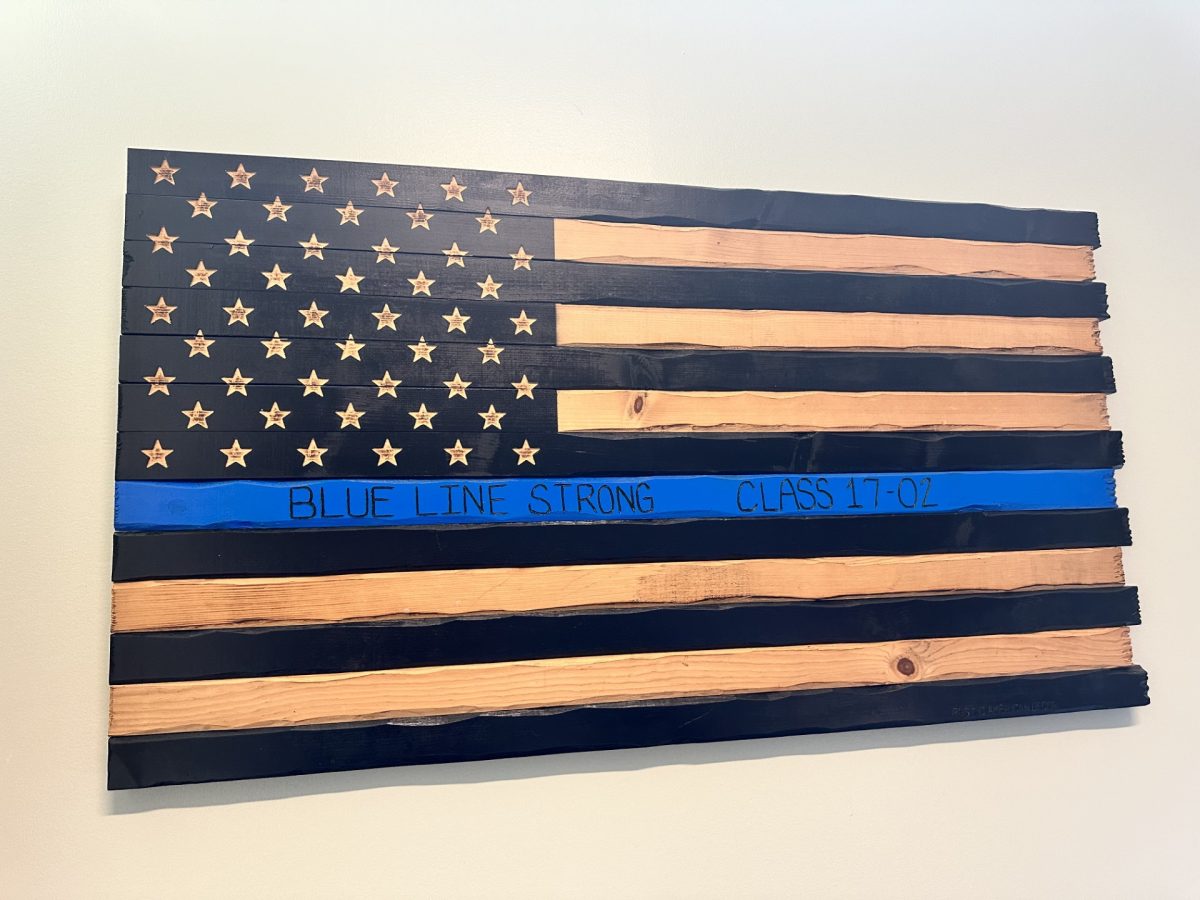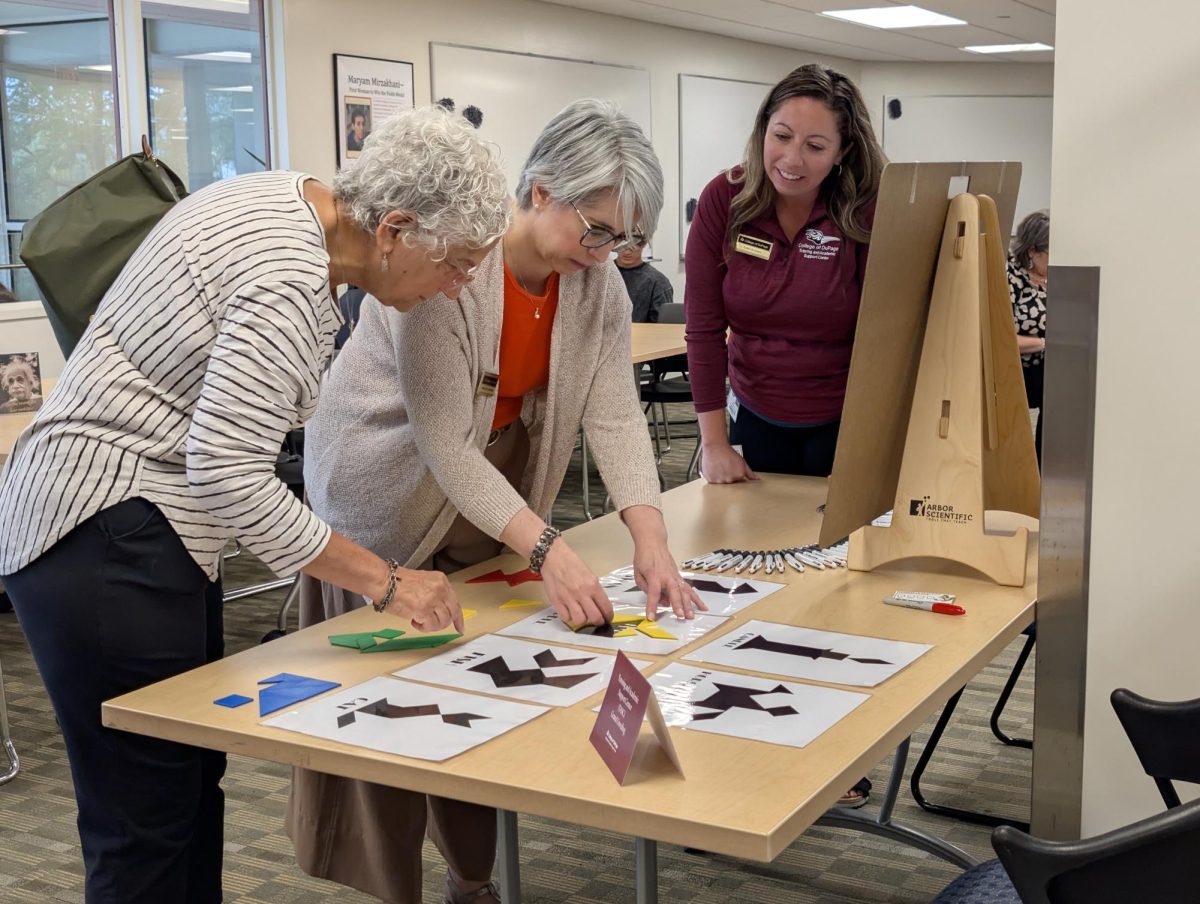Displays of Thin Blue Line flags from certain faculty at the Homeland Security Education Center (HEC) have created tension inside and outside COD regarding how these displays fuel both deep pride and contrasting intense feelings of divisiveness.
Members of the Suburban Law Enforcement Academy (SLEA), an agency at COD that trains law enforcement and public safety officials, have displayed Blue Line flag material in office spaces and within a memorial for fallen police officers on the second floor of the HEC.
At COD’s Sept. 21. board of trustees (BOT) meeting, Frank Giammarese, the director of public safety for the Bloomingdale Police Department, expressed concern that any removal of Blue Line flags at COD, in particular in the memorial for fallen Bloomingdale police officer Raymond Murrell, would be a dishonor to police and Murrell’s service. Murrell was a graduate of the SLEA program and a police officer in Bloomingdale who died in a car accident in 2017.
“We’ve learned that the Blue Line flag and the police memorial has come under scrutiny from what I’m told is Theodore Darden,” Giammarese said.
Theodore Darden is a full-time criminal justice professor at COD. During a recent tour of the HEC to visitors at the college, members of the public expressed concerns about the Blue Line flag displays.
After Darden assessed controversies connected to the Blue Line flag, both he and the criminal justice faculty as a whole believed a conversation with the administration needed to happen over their display.
“I have never asked anyone to remove a memorial of any sorts from this institution,” Darden said. “The words spoken by a couple of people, including (Giammarese) at the board meeting on Sep. 21, invoking my name as someone who asked for a memorial to be removed is utterly false and untruthful.”
Darden was not present at the board meeting but provided his thoughts in a subsequent interview.
For Giammarese and members of SLEA, displaying the Blue Line flag represents honor and unity for law enforcement. It’s also a way for trainees in the academy to continue establishing a level of respect for the profession.
“It’s disheartening to us. It kind of hit us in the gut that would even be compromised or potentially taken down,” Giammarese said at the meeting. “Ray was biracial, so if people tell me that the blue line flag has a racial component, we don’t see that,” Giammarese said. “We are about serving – protecting all people. It doesn’t matter what color you are.”
If COD were to remove the flags, Giammarese said he would withdraw Bloomingdale’s support from the academy. For their 16-week program at COD, the current tuition for one police recruit to train at SLEA is $4,696, according to SLEA’s FAQ page. Both agencies and communities involved with SLEA budget these training costs into their annual budget.
“If the College of DuPage decides to take this police memorial down and this police flag down, I will take every resource out of the academy,” Giammarese said. “I will not allow another potential probationary police officer to be part of this academy. That’s how much that means to us.”
At the same BOT meeting, a statement from Darden was read by several faculty members as he remained absent allegedly due to threats brought against him from people online.
“I understand some people believe the Blue Line flag is meant to be in support of police officers, and no one should question those individuals’ sincerity,” the statement read. “However, it is important to understand the full historical context the flag represents.”
His statement tied the Blue Line flag to its usage by white supremacists, alongside the Jan. 6 insurrection, and as a symbol used in opposition to movements in support of police reform and Black Lives Matter.
“In short, the Blue Line flag carries multiple meanings for multiple groups for multiple purposes,” the statement read. “To portray the Blue Line flag to have only one meaning would be inaccurate.”
His statement goes into the history of the Thin Blue Line, calling it problematic and its historical associations with “normalizing police brutality” and a “police subculture that pressures its ranks not to report wrongdoing by fellow officers.”
Several examples of where the Blue Line flag has been taken down by agencies and communities around the country are mentioned in his statement. One example included is a decision from 2021 where the flag was removed from police uniforms in Mount Prospect, Ill.
“The college must be purposeful in its intent and inclusive in its activities so everyone feels welcome, safe and worthy,” Darden’s statement read. “These are the environments that produce new ideas, expand outcomes and support limitless potential. The college should not want to promote nor advance a culture of us against them, but instead, us with them.”
In an email to all faculty and staff from COD’s President Brian Caputo on Sep. 21, he appointed Vice President Walter Johnson to study and explore the display of flags and memorials both on the main campus and in its centers. Johnson is a former member of the Naperville Fire and Police Commission.
“I believe that it is critically important that we use a methodical, thorough and thoughtful approach throughout this important examination,” Caputo said in the statement. “This issue has the potential for broad impacts on college policy and community belonging as we work together to identify the best long-term solution.”
As various groups at COD continue to have conversations over what can and cannot be displayed on campus, Darden emphasized that the initiative behind all discussions on the Blue Line flag are for the betterment of COD’s community.
“Just so I am clear, the discussion around the Blue Line flag at COD has always been about the college, students and visitors,” Darden said. “It has and will always be an issue that is ultimately left up to the college administration to decide. This was a concern that was brought forth by visitors and criminal justice studies faculty believed it warranted the college’s attention.”
At the BOT meeting, COD student Luis Medina talked about his involvement with Latinos Unidos, a club on campus that pushes toward creating academic, social and community connections between Latino students. As a club that suffered through the pandemic, he called these flags another challenge for the Latino culture on campus to overcome.
“Two years later we are once again celebrating our culture,” Medina said. “Two years later, when our Latino community is at the midst of once again being comfortable in showing their presence at this institution, another roadblock towards the path of comfortability.”
Medina urged trustees to not only recognize student voices like his but to also consider how many of those voices can go unheard.
“I can guarantee you that I am not the only student who has seen these symbols and has been harmed by them,” Medina said. “These symbols are powerful – powerful enough to make students so afraid and uncomfortable that they stay quiet.”
This is a developing story, and The Courier will continue to provide updates as it continues. There is no public timetable attached to Johnson’s review of the flags.












M • Nov 11, 2023 at 6:16 pm
I’m a student here and the police that work here have lost my respect. They’ve been nothing but aggressive and making noise during classes ever since this issue has been brought up. It’s like taking away a child’s pacifier and they stomp around.
mike diver • Nov 10, 2023 at 9:59 am
No person nor organization should object to this display. It signifies support of civility, patriotism, and law enforcement.
Tom P • Oct 18, 2023 at 7:14 pm
This is beyond absurd that this is even a topic that needs to be discussed. When something goes wrong (anywhere, anytime, anyplace) the first thig people say is CALL 911. That brings Police and or Fire/Medis to the need of their citizens in the community. I am a Veteran, and I was also a Firefighter/Paramedic who worked side by side with those in the Blue. I stand by them through thick and thin, just like I would with any of my COD fellow students who needed help. If a symbol of the AMERICAN flag with a Blue line in it “HARMS” you then you need to reevaluate you understanding of the old saying “Stick and stones will break my bones but words can never hurt me”. If a flag offends someone then I Challange them to go on a ride along in Englewood, Roseland or the West Side of Chicago with Cops, Fire and Paramedics. THEN come have a conversation with a Veteran who knows what that “harmful” symbol really stands for and what its about. Bless America. The greatest country in the world where we can say whatever we want.
Steve • Oct 17, 2023 at 9:54 am
I suggest everyone look up the United States flag code.
Greg • Oct 25, 2023 at 6:08 am
The term “should” used throughout the US Flag Code does not invoke a mandatory “rule of law” adherence to the guidelines. To do so, would be in strict conflict of the First and Fourteenth Amendments of the US Constitution. Those who uphold your constitutional rights should be honored with dignity and respect. The Blue Line flag symbolizes the respect and honor our police deserve.